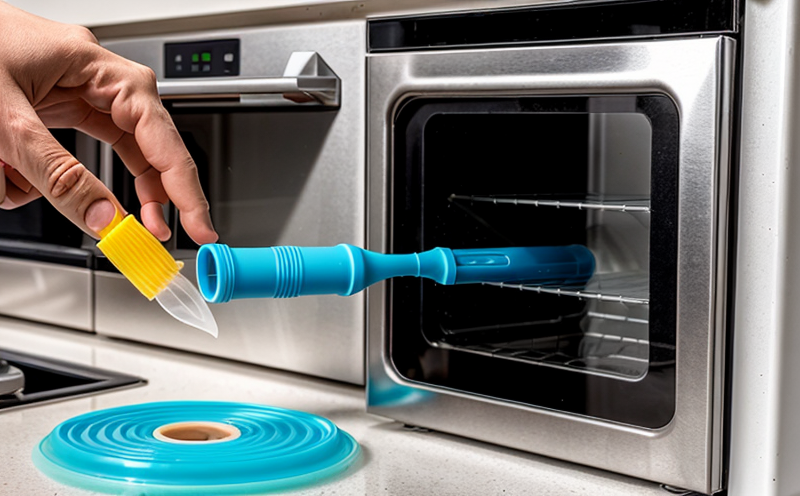UL 94 Household Plastics Flammability Testing
The UL 94 household plastics flammability test is a critical standard that evaluates the resistance of plastic materials to ignition and flame propagation. This test is essential for ensuring safety in consumer products, particularly those found within the home environment such as furniture, electronics, toys, and packaging.
The UL 94 standard was originally developed by Underwriters Laboratories to provide a standardized method for evaluating the flammability of plastics used in household appliances and other consumer items. The test measures how rapidly flames spread across the surface of the material when exposed to an open flame source. This helps manufacturers ensure their products meet safety requirements set forth by regulatory bodies, including the Consumer Product Safety Commission (CPSC) in the United States.
UL 94 testing typically involves placing a specimen of plastic on a vertical or horizontal holder and exposing it to a small flame. The duration for which the material remains alight is measured along with other parameters like burn rate and smoke density. Based on these results, materials are classified into different categories (H, V-0, V-1, V-2) depending on their performance.
The importance of this test cannot be overstated given that household plastics often come into direct contact with consumers, especially children. Ensuring they do not ignite easily or burn rapidly is crucial for protecting public health and safety. By adhering to UL 94 standards during product design and manufacturing processes, companies can demonstrate their commitment to producing safe and reliable products.
Understanding the nuances of this test allows engineers and quality assurance teams to make informed decisions about material selection and process optimization. For instance, certain additives like flame retardants may be added to improve a plastic's resistance to ignition; however, these must also comply with other environmental regulations. Thus, UL 94 testing plays an integral role in balancing safety concerns with sustainability practices.
Compliance with the UL 94 standard is often required by law or industry-specific guidelines. It ensures that products meet minimum flammability requirements and can be sold confidently knowing they have undergone rigorous evaluation. Understanding the specific criteria for each category (H, V-0, etc.) helps businesses assess whether their materials will pass the test successfully.
In summary, UL 94 household plastics flammability testing is more than just a regulatory requirement; it serves as a cornerstone in safeguarding consumer welfare by preventing potentially hazardous situations caused by easily combustible materials. By incorporating this standard into development cycles early on, organizations can enhance product quality while maintaining compliance with relevant regulations.
Why It Matters
The UL 94 household plastics flammability test is paramount for several reasons:
- Consumer Safety: Ensuring that household items containing plastic do not catch fire easily helps protect families from accidental burns and other injuries.
- Liability Protection: Compliance with this standard can help manufacturers avoid legal action if their products pose a risk to users.
- Market Access: Many countries require compliance with UL 94 standards as part of import regulations, which opens up international markets for compliant businesses.
- Sustainability: Flame retardants used in some tests can affect the environment. Testing ensures that these chemicals are used responsibly and effectively.
The test results provide valuable insights into a material's behavior under controlled conditions, enabling continuous improvement in product design and manufacturing processes. This proactive approach fosters innovation while maintaining stringent safety standards.
Applied Standards
The UL 94 household plastics flammability testing is based on several internationally recognized standards:
- UL 94V-0: This standard requires the plastic to self-extinguish within 10 seconds after removal from the flame source. It indicates that the material has excellent resistance to ignition.
- UL 94V-1: Similar to V-0 but allows for a longer self-extinction time of up to 30 seconds, meaning it still provides strong protection against fire hazards.
- UL 94H: This category indicates that the plastic does not burn continuously when exposed to flames. It is suitable for low-flammability requirements but offers less stringent criteria compared to V categories.
In addition, other international standards such as ISO and ASTM may also apply depending on regional regulations or specific industry needs. These standards further refine the testing parameters and acceptance criteria for various types of plastics used in different applications.
Quality and Reliability Assurance
The UL 94 household plastics flammability test is conducted using precise equipment and methods to ensure accurate results. Here's a detailed look at the process:
- Specimen Preparation: Specimens must be cut to specific dimensions as per the standard requirements. Proper preparation ensures consistent testing outcomes.
- Instrumentation: High-quality flame sources and detection devices are used to simulate real-world conditions accurately. These tools measure temperature, duration of burning, and other relevant factors.
- Data Collection: Detailed records are kept throughout the test, including video recordings for review if necessary. This data is crucial for evaluating performance against specified limits.
The results from these tests are then analyzed to determine compliance with the applicable category (V-0, V-1, H). Non-compliance may lead to further investigations or modifications in product design until satisfactory results are achieved.
Quality and reliability assurance extend beyond just passing this test. Regular audits by independent agencies verify ongoing adherence to best practices and continuous improvement efforts within manufacturing facilities. Such measures instill confidence among stakeholders that products meet the highest standards of safety and quality.





